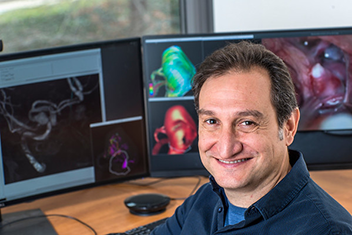We are trying to understand how aneurysms form, progress, and rupture.
Juan Raul Cebral

Juan Raul Cebral is using image-based computational modeling to study blood flow in the brain to learn more about aneurysms.
A bioengineering researcher is combining math and medicine to help patients who have strokes and other cerebrovascular disease.
Juan Raul Cebral uses image-based computational modeling to study blood flow in the brain so he can learn more about aneurysms. A cerebral aneurysm is a ballooning, weak area in the wall of an artery that supplies blood to the brain. If it ruptures, it can cause a hemorrhagic stroke, which can lead to death or brain damage.
“We are trying to understand how aneurysms form, progress, and rupture,” says Cebral, PhD Computational Sciences and Informatics ’96.
A professor in the Department of Bioengineering, Cebral has funding for three research projects from the National Institutes of Health (NIH) and one from Philips Healthcare.
In one NIH-funded study, Cebral and his team, which includes two research professors and three PhD students, created a database of more than 2,000 aneurysm cases from Inova Fairfax Hospital, Mayo Clinic, and Mount Sinai Medical Center in New York. They’re using that data to develop models to predict which aneurysms are most likely to rupture.
The risk of an incidental aneurysm rupture—one with no symptoms that’s discovered by chance—is below one percent, but if it ruptures, about 50 percent of people die, Cebral says. About 50 percent of the other half never recover a normal life because of bleeding into the brain. “That’s devastating,” he says.
When physicians try to determine a patient’s risk of a rupture, they consider the aneurysm’s size and location. They also look at the patient’s age, gender, family history, smoking habits, and blood pressure, Cebral says.
Current imaging tools give doctors some insights into the risks of a rupture, but the tools don’t reveal sufficient details about flow dynamics (the blood flow in the arteries of the brain), the body’s biological response to those flows, or the artery wall biomechanics, he says. “These may be the most important characteristics in determining which aneurysms will rupture.”
It is not very well understood how the aneurysms form in the first place, but it’s thought that abnormal blood flow conditions result in arterial degeneration, he says. An aneurysm starts to grow, and the artery wall progressively degenerates and weakens.
To gain insights into this process, Cebral and colleagues are using three-dimensional images of patients’ aneurysms and constructing patient-specific computational models. “In those models, we’re solving the mathematical equations that represent the flow inside these arteries.”
“We are trying to better understand the interaction between the flow dynamics, the biological responses, and the artery wall biomechanics,” Cebral says. “If we understand these mechanisms hopefully new drug therapies that attack those specific mechanisms could be designed.”
This research also may help identify which patients to treat with medications or surgical interventions. If physicians treat everybody, they may injure many people who don’t need invasive surgical treatment, but if they don’t treat the patients who need it, then their aneurysms may rupture, Cebral says.
He is also working on another NIH-funded study with several other major universities and hospitals in the United States and Finland. In that study, Cebral and his team are developing computational tools that combine different data about the aneurysm, including information acquired from tissue harvested during surgery. “We are mapping all these pieces of data into a single model.”
Cebral says his research is rewarding because he’s using his expertise in computational flow dynamics to contribute to the medical field. “I hope our work may one day result in new diagnostic tools and therapies that will transform brain aneurysms into an innocuous disease that’s easy to manage.”
I hope our work may one day result in new diagnostic tools and therapies that will transform brain aneurysms into an innocuous disease that’s easy to manage.
Juan Raul Cebral
